Fix DRIVER IRQL_LESS_OR_NOT_EQUAL Error in Windows 10
When Windows 10 runs well, it runs exceptionally well. When it doesn’t run well, you are likely to see the dreaded blue screen of death (BSOD) more often than your desktop. The BSOD doesn’t offer much help in resolving the errors that caused it. In fact, Windows by default will restart your system seconds after showing you the BSOD. You’ll be lucky if you can catch the actual error that caused it.
DRIVER IRQL_LESS_OR_NOT_EQUAL is an error that Windows 10 users often see.
It triggers the BSOD and Windows 10 tells you to Google the solution. This error is complicated and difficult to pin on any one thing. Here are a few things you can try to resolve the DRIVER IRQL_LESS_OR_NOT_EQUAL error.
DRIVER IRQL_LESS_OR_NOT_EQUAL Error
The DRIVER IRQL_LESS_OR_NOT_EQUAL error applies to a broad range of problems that a system might encounter. It means that your driver is having a hard time communicating with the hardware. There is noone size fits all solution for it, but chances are one of the following solutions will resolve it.
Solution 1 – Update All Drivers and BIOS
Ccheck and update all drivers. Ideally you should download these drivers directly from the manufacturer’s website as the drivers downloaded by Windows Update risk being either out of date or incompatible in a few cases. Download the correct version corresponding to your model. Your hardware’s model number will be listed on the box it shipped in. If you do not have the box, you can check the device itself (should be in one of the corners).
If an update for your BIOS (the first screen you see when you power up your system) is out, definitely update that as well. Sometimes drivers are written in compliance with an updated BIOS which can put you at risk of a BSOD.
Solution 2 – Event Viewer
If the above solution does not work, then you need to identify where the problem might be coming from. Windows has a built-in tool for that called ‘Event Viewer’. You can search for it in the Windows Search bar/Cortana.
The Event Viewer will have a log of all critical errors, warnings and messages with their time stamps. It might be a little tedious, but if you scroll through each critical error, you will be able to identify which device caused issues. If the issue is recurring with the same device, you will have identified the problem right there.

If it is a matter of faulty drivers, then you will need to completely remove the old one and install them again. First download the latest driver from the manufacturer’s website, then remove the driver using the following steps:
- Open the Control Panel
- Go to Device Manager
- Right click the device that is causing the error
- Select ‘Uninstall’ from the context menu
After it is completely removed, install the downloaded driver and restart your computer.
Solution 3 – Remove Overclocking Tool
Overclocking tools, by design, are meant to boost your hardware’s performance beyond its limits. Remove all overclocking tools and restore your hardware to factory defaults. Then remove the overclocking software. The problem should be gone.
If you want to overclock again, reinstall a fresh copy of the software and this time do it gradually so as not to push your hardware to its breaking point again. The error might be a result of Windows 10 not working well with your overclocking tool. It is possible you might have to choose between running Windows 10 smoothly or overclocking your system.
Solution 4 – Reinstall Audio/Network Drivers
If updating the drivers did not work, you might want to consider removing and reinstalling any faulty drivers. Sometimes Windows installs a generic version of a driver that ends up conflicting with the hardware. In order to address that, first download your hardware’s exact driver from its manufacturer’s website (for your exact model). To check the exact model, refer to the original box. If you do not have the box, unplug the device and examine it physically for a model number.
If you have more than one network device installed, then do the following for each one.
- Open the Control Panel app
- Loko for the Device Manager
- Right Click on the Network Adapter
- Click ‘Uninstall’ from the context menu
After that, install your downloaded driver and the error should be gone. Next time you need to update that particular driver, get a new one from the manufacturer’s website. Avoid letting Windows download that driver for you and you should be fine.
If the problem still persists, see if you can try using an external or a different network device (i.e. one that you can plug in and remove manually).
Solution 5 – Update/Change VPN software
Technically, this is error also a network issue because VPN software is supposed to redirect your traffic to a different location around the planet. Sometimes, outdated VPN software makes requests that the hardware does not know how to fulfill. Updating your VPN software should help eliminate problems.
If the problem still persists, remove the VPN software from Control Panel > Programs and Features > Right Click > Uninstall. If that solution works, you might have to change VPN software you use to one that is compatible with your system.
Solution 6 – Anti-Virus/Firewall Tools
Third-party security tools can provide decent protection for your system. In some cases, security measures might interfere with the system’s regular performance (akin to taking too much medicine to cure a small disease). Removing said protection software should resolve the problem. Try using a different anti-virus to keep your system secure.
In order to completely remove an antivirus software we strongly advise that you use one of the dedicated uninstallers. Most antivirus companies have uninstaller tools available on their websites, and use them to remove a certain antivirus program from your PC.
After you’ve removed your antivirus software, you can try to reinstall it, or you can install any other antivirus software instead.
Solution 7 – Reset your Windows 10
If all else fails and you’ve ruled out any physical defects, then perhaps a complete reset is in order. This will delete all of your files and settings from Windows 10, as well as any apps that you’ve installed. You will need to take a backup and restore it afterwards. Follow these steps to reset Windows 10.
Open the Settings app and go to the Update & Security group of settings. Go to the Recovery tab and select Reset this PC.

Select Remove Everything and reset Windows 10
Solution 8 – Check your Hardware
If all software solutions have been exhausted, it may behoove one to examine the hardware for physical defects. Sometimes the cooling system under-performs, overheating your system and sometimes Windows does not generate temperature warnings. You could open your system to individually unplug, unscrew, remove, examine for physical defects (like burn marks or excessive dust), clean and reinstall each part. If you’re not sure what to look for, consider taking your system to a professional.
